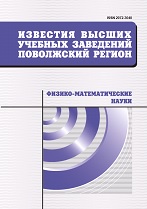|
Physics
The degradation of InGaN/GaN-based structures under the action of gamma-radiation
L. N. Vostretsova, M. Yu. Makhmud-Akhunov, A. A. Chulakova
Ulyanovsk State University, Ulyanovsk
Abstract:
Background. Currently, GaN/InGaN heterostructures are the main element base of modern optoelectronics. The widespread use of InGaN-based structures causes high reliability requirements. In order to ensure high reliability of photostructures, it is necessary to understand the mechanisms of radiative and non-radiative recombination, degradation mechanisms in these materials, and, consequently, to understand the nature of internal defects that affect the electrical and optical characteristics of LEDs. An important place is given to the study of the radiation resistance of heterostructures based on InGaN/GaN, which is associated with the ability to reveal the nature of defects existing in the studied samples, to investigate the effect of detected defects on the effectiveness of LED structures. The purpose of this work is to study the effect of gamma radiation on the electrical characteristics of LED structures based on InGaN/GaN blue glow. Materials and methods. Blue LEDs based on InGaN/GaN (wavelength at room temperature 470 nm) are being investigated. To achieve this goal, direct and reverse volt-ampere characteristics were measured on an automated measuring unit in the range of gamma radiation doses of 0-0.4 MRad. The methods of recombination spectroscopy and nonstationary deep-level spectroscopy were used to explain the detected changes in the volt-ampere characteristics. Results. It is established that the main mechanism of current transfer in the voltage range up to 2.5 V for the studied structures is tunneling. In the same voltage range, the dependence of the forward and reverse current on the dose of gamma radiation is observed: at 0.2 MRad, there is a decrease in current relative to the unirradiated sample, at 0.4 MRad, an increase in current relative to the unirradiated sample. Recombination spectroscopy and unsteady spectroscopy of deep levels revealed a level with an energy of 0.6 $\pm$ 0,02 eV involved in the creation of a tunnel flow. Conclusions. Using a generalized recombination model, it is shown that the magnitude of the tunnel current depends on the concentration of deep centers that create energy levels in the forbidden zone. The recombination spectroscopy method (according to the dependence $d\beta/dU=f(U)$, where $\beta$ is the differential indicator of the slope of the volt-ampere characteristics) established the effect of gamma irradiation on the concentration of deep levels involved in the creation of a tunnel flow. It is shown that at a dose of 0.2 MRad, the amplitude of the extremum decreases, and at 0.4 MRad increases, which is consistent with the behavior of forward and reverse tunneling.
Keywords:
LED, quantum well, gamma irradiation, recombination spectroscopy.
Citation:
L. N. Vostretsova, M. Yu. Makhmud-Akhunov, A. A. Chulakova, “The degradation of InGaN/GaN-based structures under the action of gamma-radiation”, University proceedings. Volga region. Physical and mathematical sciences, 2022, no. 3, 72–84
Linking options:
https://www.mathnet.ru/eng/ivpnz218 https://www.mathnet.ru/eng/ivpnz/y2022/i3/p72
|

| Statistics & downloads: |
| Abstract page: | 54 | | Full-text PDF : | 21 | | References: | 19 |
|




 Contact us:
Contact us: Terms of Use
Terms of Use
 Registration to the website
Registration to the website Logotypes
Logotypes








 Citation in format
Citation in format 